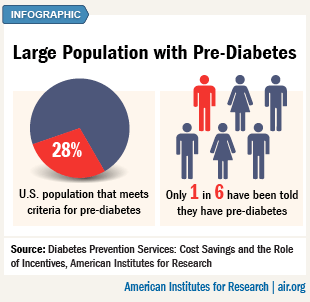Twenty-Eight Percent of Adult Americans Have Risk Factors for Pre-Diabetes But Five Out of Six Don’t Know It
Washington, D.C. – Approximately 28 percent of U.S. adults have several of the risk factors for pre-diabetes but only one out of six are aware of it, according to a study by the American Institutes for Research (AIR) that found providing services that would prevent or delay the onset of the disease could generate savings for the federal government and private providers.
While the study found that prevention has long-term financial benefits, most health care providers currently do not have the incentives needed to provide these services, even though they can lower total healthcare costs over time.
“Our core finding was that prevention pays but that the landscape of the current health system does not include the incentives to encourage preventative care. This analysis provides information that contributes to developing an effective long-term strategy,” said Nalini Pande, one of the lead authors of the report.
 Pre-diabetes occurs when an individual’s blood sugar level is higher than normal. The Centers for Disease Control and Prevention (CDC) notes that unless steps are taken to address the condition, it is likely to become type 2 diabetes within 10 years or less. Pre-diabetes increases the likelihood of diabetes, heart disease and stroke. Diabetes is the seventh leading cause of death in the United States, according to CDC.
Pre-diabetes occurs when an individual’s blood sugar level is higher than normal. The Centers for Disease Control and Prevention (CDC) notes that unless steps are taken to address the condition, it is likely to become type 2 diabetes within 10 years or less. Pre-diabetes increases the likelihood of diabetes, heart disease and stroke. Diabetes is the seventh leading cause of death in the United States, according to CDC.
Approximately 57 million Americans aged 20 or older have pre-diabetes, according to the AIR analysis. Of this group, 12 million individuals between the ages of 20 and 39 have pre-diabetes, and more than 7 million between the ages of 55 and 59 have pre-diabetes. At the same time, only about one in six say they have been told by health care providers that they have pre-diabetes. For example, an estimated 25 million adults aged 55 and older have multiple pre-diabetes risk factors but only 4.6 million are aware of it.
AIR’s estimate of those with pre-diabetes is based on an analysis of data collected in 2009-2010 by the National Health and Nutrition Examination Survey (NHANES) conducted by CDC. A 2011 CDC report found in one year the total cost of diabetes (Type 1 and 2) was $174 billion, including both direct medical costs and those related to disability, work loss, and premature death.
“Given the cost of diseases like diabetes to society, AIR’s analysis shows the need to understand which prevention services are most effective and also how to best target them to realize savings” said economist Dan Sherman, an author of the report.
AIR analysts looked at incentives for three models of health financing and delivery systems to offer prevention services: private sector; federal government; and an accountable care organization (ACO) – a network of doctors and hospitals that work together to share responsibility for the cost and quality of patient care. In all three models, individuals would transfer to Medicare when they reach 65. However, in the ACO model, the ACO would share savings with Medicare under a two-sided risk/shared savings agreement.
In general, the analysis found that it could take at least 10 years for the cost of a prevention program to be offset by savings on medical expenses for private plans. Because of the length of time to recover costs, private plans would have less incentive to offer prevention programs, especially to individuals in their 50s and early 60s who would enter Medicare when the savings would be realized. However, the federal government would have direct benefits if private health plans provided these services to this population, since most individuals enter the Medicare program once they reach 65. In fact, the study found the federal government would have an incentive to provide funding to private plans to offer prevention programs.
The largest potential savings could come under the ACO model where there would be an incentive to provide prevention services to individuals of all ages as long as most of their participants remain within the ACO once they are eligible for Medicare.
The analysis was conducted for the Bipartisan Policy Center (BPC) in Washington, D.C., as part of its Health Care Cost Containment Initiative. With this initiative, BPC embarked on an effort to address unsustainable health care cost growth in the United States. Under the leadership of former Senate Majority Leaders Tom Daschle (D-SD) and Bill Frist (R-TN), former Senator Pete Domenici (R-NM), and former White House and Congressional Budget Office Director Dr. Alice Rivlin, BPC’s Health Care Cost Containment Initiative explored and evaluated strategies to contain health care cost growth on a system-wide basis, while enhancing health care quality and value.
To read the full report, visit www.air.org.
About AIR
Established in 1946, with headquarters in Washington, D.C., the American Institutes for Research (AIR) is a nonpartisan, not-for-profit organization that conducts behavioral and social science research and delivers technical assistance both domestically and internationally in the areas of health, education and workforce productivity. For more information, visit www.air.org.
About BPC
Founded in 2007 by former Senate Majority Leaders Howard Baker, Tom Daschle, Bob Dole and George Mitchell, the BPC is a non-profit organization in Washington, D.C. that drives principled solutions through rigorous analysis, reasoned negotiation and respectful dialogue. With projects in multiple issue areas, BPC combines politically balanced policymaking with strong, proactive advocacy and outreach. For more information, please visit www.bipartisanpolicy.org.
###